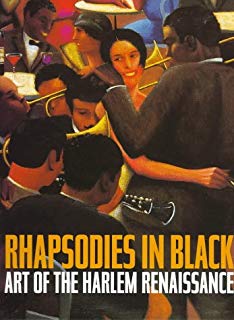RHAPSODIES IN BLACK:

Music and Words From The
Harlem Renaissance
4 CD Set
Rhino
The Harlem Renaissance (roughly1915-1937), like the Armenian holocaust or the bombing of Dresden, is a rarely talked about yet monumental event in history. Unlike the holocaust in Turkey or the immolation of Dresden however, the Harlem Renaissance was cause for celebration. Started around 1915 after the death of Booker T. Washington, the Renaissance was ushered in by black artists, writers and performers who, unlike Washington, had not been born into slavery. The freedom of living in a city community like Harlem, allowed blacks, for possibly the first time in their history as Americans, to imagine and create the natural bi-product of decades of suffering: art. While repressed, covert art was made during their years of slavery, this was the first time that their art could be unfurled in the bright light of day. On top of that, it was so amazing that white people flocked to Harlem to witness the spectacle. The Harlem Renaissance beget the Beat Generation of New York, which beget the hippies of San Francisco, which beget the yippees, out of which rose the yuppies. It would seem that the roots of all our most revolutionary and noteworthy movements are black, as coal, as earth, black as the night before the first rays of dawn. Rhino Records four CD set, RHAPSODIES IN BLACK, MUSIC AND WORDS FROM THE HARLEM RENAISSANCE attempts to sample this slice of Americana that is usually only remembered for it’s sound bytes: Duke Elllington, the Cotton Club, Langston Hughes. Fortunately for history and the savvy box set collector, Rhino has managed to reach back into the archives of Sony, RCA, UMG and a few choice collections to give a fuller, more vibrant look at a where greatness existed for a short time, than any other collection to date .
The music recordings, while re-mastered as well as possible, are not the kind of stereo driven music we are used to. Recording technology, like the rise of this new black culture, was in its infancy and in the end we are lucky to have what we do. Forgiving the technical quality, there is a haunting quality to the recordings present in the collection that makes you yearn for a dim place to listen. As Bert Williams sings “Brother Low Down” or Ethel Waters accompanied by her Jazz Masters belts out “There’ll be Some Changes Made” or “Stormy Weather” close your eyes and imagine what it was like to hear something like that for the first time. A favorite of mine on disc three (Preachin’ & Prayin’) was “My Handy Man” by Victoria Spivey. There is a hopefulness to the music, even below the blue note, that is not present in black music today which lifts the heart even while the soul is feeling low.
Another hurdle the editors of the set had to get over was the lack of any recordings of spoken word. Poetry and fiction had a place in the Harlem Renaissance on a par with music. Langston Hughes, W.E.B. Dubois, Zora Neale Hurston have survived times short term memory, but lesser known writers like Sterling Brown and Arna Bontemps are also here. The problem is that while their voices live on in print, there were no recordings for Rhino to pilfer. So they did the only thing an LA based retro record company could do, they hired local talent to do the job. I would love to have been around for the meeting where they decided who to commission to read the 20 spoken word pieces in the set. One of the most inspired readings opens disc three. Rap singer Ice-T reads a poem by Claude McKay called, “If We Must Die”.” “If we must die, let it not be like hogs/ Hunted and penned in an inglorious spot, / While round us bark the mad and hungry dogs, / Making their mock at our accursed lot….”) I understand the necessity of today’s bleak up front poetry and song, but to hear passion and anger presented so eloquently is awe-inspiring. Actress Alfre Woodard, a force in her own right, brings life to “I Want to Die While You Love Me” by Georgia Douglas Johnson on disc 4 (Lustin’ for Love & Life). Ms. Johnson could have been speaking of the Harlem Renaissance itself when she wrote the lines: “I want to die why you love me, / and never, never see / The glory of this perfect day / Grow dim or cease to be.”
Any collection is imperfect. It cannot contain be all things to all people, but as with any relationship, compromise is the key. Here are four CD’s with 85 tracks full of music, poetry and literature that you won’t find put together anywhere else. Certainly not in a beautiful box complete with a thick book of liner notes with essays chronicling the history of the Harlem Renaissance, so run don’t walk to the record store.
Carlye Archibeque
